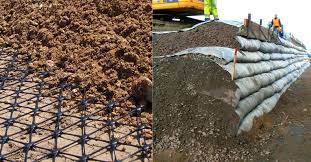Geogrids, a crucial component in various civil engineering projects, play a pivotal role in enhancing the stability and longevity of structures. In this comprehensive guide, we delve into the intricacies of geogrids, exploring their applications, types, installation methods, and the benefits they offer.
What is a Geogrid?
A geogrid is a geosynthetic material commonly used in construction and civil engineering projects to reinforce soil. It typically consists of polymer materials, such as polyester, polyethylene, or polypropylene, arranged in a grid-like pattern. This configuration provides strength and stability to the soil, improving its load-bearing capacity and preventing soil erosion.
Types of Geogrids
Geogrids come in various types, each tailored to specific applications and project requirements:
1. Uniaxial Geogrids
Uniaxial geogrids have strength predominantly along one axis, making them ideal for applications where reinforcement is required in one direction, such as retaining walls and steep slopes.
2. Biaxial Geogrids
Biaxial geogrids offer strength in both the longitudinal and transverse directions, providing uniform reinforcement across the entire structure. They are commonly used in applications like pavement construction, soil stabilization, and embankment reinforcement.
3. Triaxial Geogrids
Triaxial geogrids, featuring strength in three directions, offer superior reinforcement capabilities, making them suitable for high-stress applications like road construction, railway embankments, and mine reclamation projects.
Applications of Geogrids
Geogrids find extensive usage across various civil engineering projects due to their versatility and effectiveness. Some common applications include:
1. Road Construction
In road construction, geogrids are used to stabilize and reinforce the subgrade soil, reducing deformation and extending the lifespan of the pavement. They help distribute loads more evenly, minimizing rutting and cracking.
2. Retaining Walls
Geogrids provide essential reinforcement in retaining wall structures, preventing soil movement and ensuring the stability of the wall over time. By improving soil confinement, they enhance the overall structural integrity of the retaining system.
3. Slope Stabilization
For slopes prone to erosion and instability, geogrids offer an effective solution by reinforcing the soil and preventing surface slippage. They help maintain slope integrity and minimize the risk of landslides or slope failure.
4. Landfills
In landfill construction, geogrids are utilized to create stable base layers and caps, enhancing containment systems and preventing the leakage of contaminants into the surrounding environment. They contribute to the long-term integrity and environmental sustainability of landfill structures.
Installation of Geogrids
Proper installation is critical to ensuring the effectiveness and performance of geogrids in engineering projects. Here are the key steps involved in the installation process:
1. Site Preparation
Before installation, the site must be adequately prepared, ensuring proper grading and compaction of the soil. Any debris or vegetation should be removed to provide a clean working surface.
2. Geogrid Placement
The geogrid should be laid out carefully over the prepared soil, ensuring alignment and overlap as per the project specifications. It’s essential to avoid any wrinkles or folds in the geogrid material during placement.
3. Anchor Installation
Anchors or fasteners may be required to secure the geogrid in place, especially in applications with high loads or slope angles. These anchors should be installed according to manufacturer guidelines, ensuring proper tension and stability.
4. Covering and Compaction
Once the geogrid is in place, the soil or aggregate cover material can be placed over it, followed by compaction to achieve the desired density and stability. Proper compaction is essential to ensure optimal performance and load-bearing capacity.
Benefits of Geogrids
The use of geogrids offers a multitude of benefits in civil engineering and construction projects:
- Improved Stability: Geogrids enhance soil stability and structural integrity, reducing the risk of settlement, deformation, and failure.
- Extended Lifespan: By distributing loads more evenly and minimizing stress on the soil, geogrids help extend the lifespan of infrastructure and reduce maintenance costs.
- Cost-Effective Solutions: Incorporating geogrids can lead to cost savings by reducing the need for extensive earthworks, materials, and maintenance over time.
- Environmental Sustainability: Geogrids promote environmentally sustainable practices by minimizing soil erosion, enhancing land reclamation efforts, and improving the performance of containment systems.
Conclusion
Geogrids are indispensable components in modern civil engineering and construction projects, offering unparalleled reinforcement and stability to soil structures. From road construction to slope stabilization and landfill management, the versatility and effectiveness of geogrids make them essential for ensuring the longevity and resilience of infrastructure worldwide. By understanding their applications, types, installation methods, and benefits, engineers and project managers can harness the full potential of geogrids to overcome challenges and achieve sustainable development goals.





